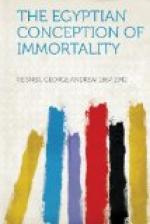However this may be, it is clear that the craving of the king for a special immortality, for an exalted future life, found its justification through the Osiris-Isis myth. Horus was the successor of Osiris as lord of the earth and the living. The kings of Egypt were the successors of Horus. The chief name of the king was his Horus name; Menes was the Horus Aha, Cheops the Horus Mejeru. When the king died, he became Osiris, and passed to the kingdom of Osiris. He passed through the underworld with the sun-god, abode there as Osiris, the god-king, or sped to the heavens to the celestial gods. Thus comes the entering wedge of a great change in the conception of immortality—an ordinary immortality for the common man, a special divine immortality for the divine man, the king. [It appears probable that the deification of the king and the assumption of a divine immortality for him was prior in time to the statement of these beliefs in the terms of the Osiris story.] Even at this early age, it was, of course, clearly stated that the king must be righteous, morally satisfactory in the eyes of the world and of the gods. The gods, as always, were on the side of the moral code, and especially on the side of the organized religion. It is perhaps significant that the chief sins of the kings of the Fourth dynasty, so execrated by the Egyptian priests in the Ptolemaic period, were sins against the great gods. The other charges are for the most part plainly slanders. In practice every king whose family remained in power was justified before gods and men, and took his place among the gods in the islands of the blessed in the northern part of the heavens.
The dead body was laid in the grave, supplied with all these magic texts which were to restore and revive the soul and guide it across waters and through dangers to the place of Osiris. But the chapel was not wanting, the cult of the ka was maintained, the statues were placed in the hidden room, the food and drink were brought daily to the door of the grave. Thus, while a special immortality was evolved for the king, the funeral customs continue to show the same service of the ka as in the earlier period.




